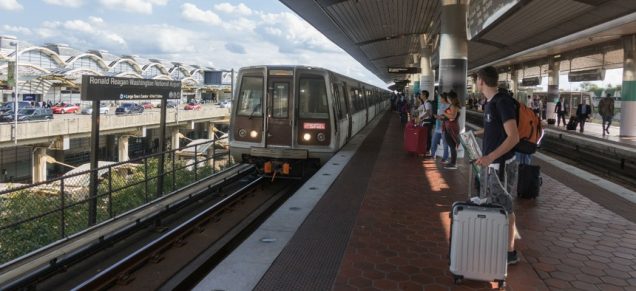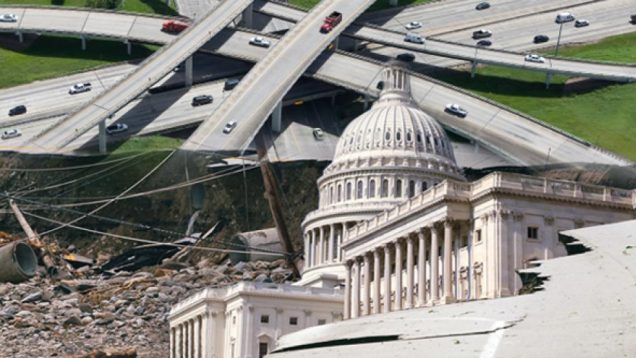Tagged: Congress
COVID-19’s Economic Impact: Can Amending the Fair Debt Collection Practices Act Help?
COVID-19’s impact on the world has been unsparing: it has taken thousands of loved ones and overburdened healthcare systems. Its economic impact has been no less devastating. Government-mandated shutdowns have forced many small businesses to shut their doors. Those lucky enough to remain open have seen a marked decrease in customers. A McKinsey & Company survey polling small and medium-sized businesses found that 59% of small or medium-sized businesses reported experiencing a “significant” drop in personal and business income. 25% had faced such a precipitous drop that they expected they would have to file for bankruptcy in the coming months. This impact will have a broad effect: these businesses represent 48% of the U.S. economy and employ over 60 million people.
COVID-19 has also been unsparing when it comes to consumers. Not only are those employed by small or mid-sized businesses losing their jobs, but even those working at large international companies are also losing their jobs or facing pay cuts. Self-employed individuals have seen their business opportunities vanish. Right now, because of moratoria on foreclosures, evictions, and debt collection, these issues are looming when the overall economy begins to resume. Without any intervening forces, a wave of evictions, foreclosures, repossessions, and bankruptcies is likely to come.
Currently, little protects consumers and small businesses during emergencies or disasters. While larger institutions are expected to have plans, even participating in stress tests with regulators, small businesses usually do not have such protective measures. Indeed, because so many operate on a thin profit margin, investing in plans to address something that seems unlikely to ever happen may seem like a waste of money. Moreover, consumers are not always going to be financially prepared either. The average American has $8,863 in their savings account. This number decreases with age: for example, young single adults under 34 have an average of $2,729 in savings. There are racial disparities too, with an average of $1,500 for Hispanic and $1,000 for Black savings account balances. (Note that this data does not include the unbanked, which is largely composed of Black and Hispanic households.)
In March 2020, Senator Sherrod Brown (D-Ohio) introduced the Small Business and Consumer Debt Collection Emergency Relief Act of 2020 (the “Act”). The Act amends the Fair Debt Collection Practices Act (“FDCPA”) to provide temporary forbearance periods after “major disasters or emergencies.” The Act could provide much-needed relief to small businesses and American consumers by expanding on current protections currently provided by the FDCPA.
Current Protections
The FDCPA became law in 1978. Its purpose was to crack down on abusive debt collection tactics. In drafting the law, Congress found that abusive debt collection practices led to “personal bankruptcies, to marital instability, to the loss of jobs, and to invasions of individual privacy.” The FDCPA covers several types of consumer debts: mortgage, credit card, student loan, and medical debts, just to name a few. Debts owed by businesses are currently not covered by the FDCPA.
One of the biggest protections afforded under the FDCPA is limiting how and when a debt collector can contact a debtor. Debt collectors cannot harass debtors, misrepresent what can occur if the debtor fails to pay, or contact the debtor in the middle of the night. While the FDCPA is imperfect—consumers regularly report violations—it provides an avenue of recourse and is regularly enforced.
The Act’s Proposals
 The Act seeks to amend the FDCPA in several ways. First, the Act amends section 3 of the FDCPA to restrict debt collection during a national disaster or emergency. The Act defines “national disaster or emergency” two ways: (1) one declared by the president under section 401 of the Robert T. Stafford Disaster Relief and Emergency Assistance Act; or (2) “an emergency involving Federal primary responsibility that is determined to exist by the President” under section 501 of that act. Next, the Act prohibits debt collectors from numerous actions ranging from charging higher fees or interest rates to seizing the property or asset at issue. Moreover, the Act pauses any legal action against the debtor, even if the proceeding began before the disaster was declared. Finally and crucially, the Act extends FDCPA protections during national disasters or emergencies to small businesses.
The Act seeks to amend the FDCPA in several ways. First, the Act amends section 3 of the FDCPA to restrict debt collection during a national disaster or emergency. The Act defines “national disaster or emergency” two ways: (1) one declared by the president under section 401 of the Robert T. Stafford Disaster Relief and Emergency Assistance Act; or (2) “an emergency involving Federal primary responsibility that is determined to exist by the President” under section 501 of that act. Next, the Act prohibits debt collectors from numerous actions ranging from charging higher fees or interest rates to seizing the property or asset at issue. Moreover, the Act pauses any legal action against the debtor, even if the proceeding began before the disaster was declared. Finally and crucially, the Act extends FDCPA protections during national disasters or emergencies to small businesses.
The Act is a way of addressing some of the consumer protection shortcomings of the CARES Act. For example, there is a 120 day moratorium on foreclosures and evictions, but only for those who have federally-backed mortgages, live in buildings financed by federally-backed mortgages, or receive rental funding through a federal program. While this covers a significant number of individuals and homes, about 30% of Americans are left out of this provision. The debt collection moratorium under the Act would extend to those Americans. It also addresses the issue the COVID-19 pandemic has made clear: small businesses suffer when they are forced to shut down, as they may not always have the resources or option to continue operating virtually. Their financial troubles largely came as the result of a forced shutdown. More generally, the Act’s amendments can cover future national emergencies or pandemics.
While this is not an overall solution to COVID-19’s economic impact, it can provide some relief to consumers and small businesses. It may allow people to be more understanding of opening up gradually rather than quickly, too. While it does not solve a reduced or lack of income, having some assurance that the car will not be repossessed or a debt collector will not be regularly calling can provide some much needed relief in what has been a stressful time. Currently, debtors do not have such relief. Despite the pandemic, debt collectors have still been calling consumers. In Massachusetts, the Attorney General’s Office sought to ban debt collection during the height of the pandemic. However, a federal judge ruled against the state’s emergency resolution. FTC guidance is not particularly helpful either: it recommends talking things out with the debt collector and asking that they stop calling. Congress has already done a lot through the CARES Act to help consumers during the pandemic. To further assist them, Congress should pass Senator Brown’s bill.
 Kathryn Buckley anticipates graduating from Boston University School of Law in May 2021.
Kathryn Buckley anticipates graduating from Boston University School of Law in May 2021.
Is the Johnson Amendment Constitutional?
My previous Dome blog entry discussed the Johnson Amendment and the fight that has surrounded the amendment since its creation in the 1950s. The Johnson Amendment was added to Section 501(c)(3) of the U.S. tax code by then-Senator Lyndon B. Johnson to limit the political activity of 501(c)(3) organizations. The Amendment prohibits 501(c)(3) organizations from endorsing or opposing political candidates. Many organizations have been trying to repeal the Johnson Amendment for years, and many argue (including members of Congress) that it violates the First Amendment of the U.S. Constitution.
Two vocal opponents of the Johnson Amendment (and the sponsors of the Free Speech Fairness Act in both houses of Congress) Senator James Lankford and Congressman Steve Scalise argue that the Amendment must be repealed to protect the First Amendment rights of 501(c)(3) non-profit employees. They argue the Bill of Rights protects the right of all Americans to freely express their ideas and opinions without persecution from the government, and the Johnson Amendment violates this right by stripping 501(c)(3) employees from being able to speak their minds about political issues. As discussed in my previous post, the Johnson Amendment prohibits 501(c)(3) employees from endorsing or opposing candidates, and violations of the Amendment risks punishment by the IRS either by fine, revocation of the organization’s tax-exempt status, or both. This, therefore, begs the question of whether the Johnson Amendment does in fact violate the First Amendment. This Dome blog post will look at legal precedent to see if the Amendment has been challenged for its constitutionality in the past, and if so, the arguments the court made in their decision.
Before going into court cases about whether or not the Johnson Amendment actually violates the First Amendment, it is important to look at the text itself. The text of the First Amendment reads:
“Congress shall make no law respecting an establishment of religion, or prohibiting the free exercise thereof; or abridging the freedom of speech, or of the press; or the right of the people peaceably to assemble, and to petition the government for a redress of grievances.”
Members of Congress and other organizations who oppose the Johnson Amendment mainly argue that it violates the freedom of speech, which is in fact why the current bill before Congress attempting to repeal the Amendment is titled the “Free Speech Fairness Act.” Within the text of the First Amendment, they argue that the Johnson Amendment is “abridging the freedom of speech” of 501(c)(3) tax-exempt nonprofit employees, but in particular religious ones, such as pastors, priests, and rabbis.
But has the constitutionality of the Johnson Amendment actually been determined by the Supreme Court as it applies to religious organizations? The answer, unfortunately, is no. However, two U.S. Court of Appeals circuits have upheld the Amendment as constitutional in the past when applied to religious organizations. The first case, Christian Echoes Nat'l Ministry v. United States (1972), involved a nonprofit religious corporation contesting the revocation of its 501(c)(3) tax-exempt status by the IRS as punishment for violating the Johnson Amendment. Through various appeals and remands, the ultimate holding by the Tenth Circuit Court of Appeals was that the organization no longer qualified as a tax exempt organization under section 501(c)(3) of the tax code. As one argument against the revocation of their status, Christian Echoes argued the Johnson Amendment was unconstitutional and violated their right to free speech. However, the court held that “in light of the fact that tax exemption is a privilege, a matter of grace rather than right... the limitations contained in Section 501(c) (3) withholding exemption from nonprofit corporations do not deprive Christian Echoes of its constitutionally guaranteed right of free speech.” Christian Echoes Nat'l Ministry v. United States, 470 F.2d 849, 857 (10th Cir. 1972). The court therefore determined the taxpayer must refrain from these political activities to obtain “the privilege of exemption,” which Christian Echoes benefited from until their status was revoked.
The argument made by the court in Christian Echoes is very similar to the argument made by proponents of the Johnson Amendment, such as the Freedom From Religion Foundation, who argue because religious organizations benefit essentially from a government subsidy, in exchange for that subsidy they relinquish some of their rights. These rights can at any time be reclaimed, but at the cost of losing the subsidy, ultimately leaving the choice between the two up to individual organizations.
The District of Columbia Circuit Court of Appeals has also taken up this issue more recently in Branch Ministries v. Rossotti (2000), regarding the constitutionality of the Johnson Amendment, but for violation of a different part of the First Amendment. In this case, a church had its tax-exempt status revoked for intervening in political campaigns, violating the Johnson Amendment. The church argued that revoking their tax-exempt status was a violation of the Free Exercise clause of the First Amendment, as in violating their right to freely exercise religion. To show the Free Exercise clause had been violated, the church had to establish their “free exercise right has been substantially burdened.” Branch Ministries v. Rossotti, 211 F.3d 137, 142 (2000). The court, however, held the Johnson Amendment did not violate the First Amendment because the church failed to establish that their free exercise right had been substantially burdened. Despite the claim by the church that by revoking their tax exempt status would threaten its very existence, the court determined this was overstated because the impact of revocation “is likely to be more symbolic than substantial,” because if they stop intervening in political campaigns they can regain their tax-exempt status, and even if they do not, “the revocation of the exemption does not convert bona fide donations into income taxable to the Church.” Therefore, the burden is not substantial enough to be considered a violation of the First Amendment. See, Branch Ministries, 211 F.3d at 142-143.
It seems currently that courts are finding the Johnson Amendment does not, in fact, violate the First Amendment. The Supreme Court has said in the past they believe tax benefits nonprofits are given are “a form of subsidy that is administered through the tax system,” which seems in line with the view of supporters of the Johnson Amendment and these two Court of Appeals cases. See, Regan v. Taxation with Representation, 461 U.S. 540, 544 (1983). They have not, however, delivered a decision on the constitutionality of the Johnson Amendment as it applies to religious organizations. Therefore, despite the Court of Appeals cases, the fight over this issue is unlikely to end until the Supreme Court formally rules on the Johnson Amendment as it applies to religious organizations once and for all.
 Kate Lipman anticipates graduating from Boston University School of Law in May 2021.
Kate Lipman anticipates graduating from Boston University School of Law in May 2021.
COVID-19 is a Perfect Opportunity to Reinvent America’s Mass Public Transit
As the coronavirus (Covid-19) has swept the globe, its impact on global health has been massive. However, this pandemic is not only wreaking havoc on the world’s physical health, but also its financial health. Throughout March 2020, as governments globally imposed restrictions on movement and on business, stocks plummeted. In response, the Federal Reserve slashed interest rates and has attempted to provide new sources of funding for business. Additionally, the federal government enacted a $2 trillion stimulus package. This package includes direct aid for businesses as well as individuals, in addition to support for the medical industry and other key parts of the economy. However, this bill merely provides a one-time cash infusion for a struggling and increasingly desperate economy. The US approach differs from what other countries have provided their citizens during this crisis. Other methods are more akin to ongoing support rather than a one-time payment. In fact, the UK government, in an attempt to curb unemployment, has promised to subsidize up to 80% of any worker’s salary who is facing unemployment, up to $2,900 a month. Many other countries have followed this model of providing continuing support to workers and businesses in an effort to limit unemployment. This is in contrast to the United States where, even after this stimulus was enacted, unemployment figures in the United States have climbed precipitously. Consequently, there have been discussions in Washington of a large infrastructure spending bill, akin to several New Deal programs, that would create thousands of jobs to help the United States economically recover as the health crisis recedes.
It has been reported that this infrastructure bill could be a multi-trillion dollar project. However, it is not clear that an agreement will be reached. For the duration of the Trump Presidency, infrastructure has been seen as a potential compromise issue that both Democrats and Republicans could support, yet an agreement has been elusive. Earlier this year, House Democrats released a proposal that would direct $760 billion towards rebuilding American highways, airports, and other infrastructure, with $10 billion going towards building community health centers. Additionally, this proposal included $329 billion for transportation systems, including $105 billion for transit agencies and maintenance. However, Trump and Congressional Democrats were not able to agree on a compromise agreement. Now that there is increased political pressure to provide jobs, an infrastructure deal is more likely than ever to occur. When it does, Congress should include vigorous funding specifically for mass transit.
First, the construction of mass transit can achieve the short term goal of the infrastructure bill: to create jobs. In fact, a recent light rail construction project between Durham County and Orange County in North Carolina was projected to create 20,000 jobs at a cost of just $2.5 billion. While it is unlikely that these job returns per investment would hold constant, these numbers suggest that a $1 trillion investment could yield 8,000,000 jobs. This would put a sizeable dent in to projected 20 million unemployment claims that could be filed as a result of the pandemic and subsequent economic downturn.
However, the United States should not throw money at a short term solution, without considering long term objectives as well. Investment in mass transit not only would result in short term jobs, but it would also yield many long term benefits that would impact society for a substantial period of time.
Studies at Harvard University indicate that commuting time is the single strongest factor in predicting the odds of escaping poverty. While this may be a function of poverty inherently being a hard burden to escape and wealthier individuals live near good transit options, this may not be the sole explanation. After housing, transportation is the biggest expense for most Americans, especially those settled along the urban fringe. In fact, 44% of all multifamily section 8 properties in the nation spend on average more than 15% of their income on transportation costs, effectively making these properties unaffordable. Yet increased availability of mass public transit could help solve this issue. Undeniably, mass transit is cheaper than the alternative: owning a car. On average a household can save around $10,000 annually by owning one fewer car and utilizing public transit.
However, American mass transit systems lag behind those of other countries. New York is the only US city where rail network ridership has increased since 2012. North America as a whole only accounts for 3.7 billion of the world’s 53 billion rail passengers. Ridership in Asia increased to 26 billion between 2012 and 2017, Europe accounts for 10 billion riders, and Latin America 6 billion. Further, American cities with popular transit systems are generally located in the north and on the coasts of the country. While many attribute this lack of public transit to America’s sprawl, a look at Canada, an equally car centric country, dispels this theory. Toronto, Montreal, and Vancouver all have buses, rapid transit, and commuter rail systems. Rather, reports have postulated that American mass transit systems have failed to gain steam because the demand for them is not present, and American’s would rather drive. Further, demand could be low because in cost cutting efforts, many bus and rail lines run less than once every 30 minutes. This lack of service restricts people’s lives in such a way that anyone who can drive, will drive.
Therefore, as Congress and the President work out an infrastructure bill in the coming days and weeks, they should invest heavily in mass public transit. Not only will this plan help solve the initial goal of providing jobs to those left unemployed by COVID-19, but it will also provide significant long term benefits to lower income groups. However, this bill must also create a framework to continue to support mass public transit projects. While it is undoubtedly beneficial to build these projects, their long term impact can only be realized if they are funded sufficiently to become a viable and preferable option to cars. Legislators must ensure that this massive expenditure is structured in a way that it can provide lasting change and provide more benefits than a one time influx of cash ever could.
 Gray Louis anticipates graduating from Boston University School of Law in May 2021.
Gray Louis anticipates graduating from Boston University School of Law in May 2021.
Mandatory Arbitration Clauses, Class Action Waivers, and the Need to Pass the FAIR Act
Mandatory arbitration clauses and class action waivers have become a fact of life for many American employees. A mandatory arbitration clause is contractual language that a company has a worker sign requiring that worker to resolve legal disputes in private arbitration — “a quasi-legal forum with no judge, no jury, and practically no government oversight”. A class action waiver is contractual language that a company has a worker sign that forfeits that employee’s right to file any claims collectively with other similarly situated workers. These provisions effectively strip away the rights of employees to challenge their employers in court with claims alleging wage and hour violations, discrimination, sexual harassment, and more. Congress must enact the FAIR Act so that our legal system vindicates employee rights to seek justice, access our courts, and end abusive employer practices.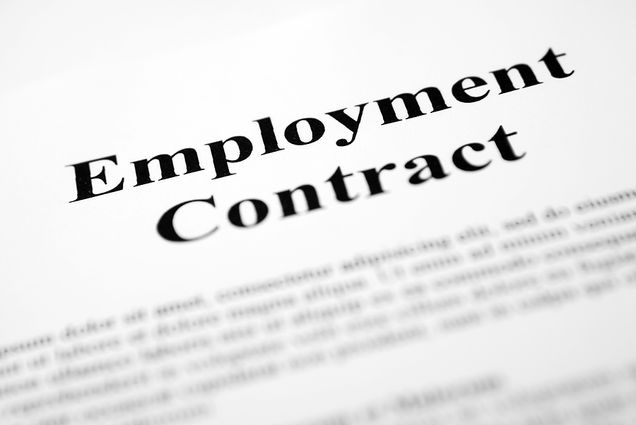
Historically, it was commonplace for American courts to decline legal enforcement of arbitration agreements, especially adhesive contracts (Epic Sys. Corp. v. Lewis, 138 S. Ct. 1612 (2018)). When Congress passed the Federal Arbitration Act (FAA) in 1925, legislative history suggests that the bill was intended to “enable merchants of roughly equal bargaining power to enter into binding agreements to arbitrate commercial disputes,” not to enforce mandatory arbitration agreements and class action waivers against workers in employment contracts. Members of Congress envisioned the FAA to provide an “opportunity to enforce…an agreement to arbitrate, when voluntarily placed in the document by the parties to it”; they did not intend to enforce the law in cases “where one party sets the terms of an agreement while the other is left [to] take it or leave it.” Until recently, courts upheld this interpretation of the FAA’s history and purpose (Prima Paint Corp. v. Flood & Conklin Mfg. Co., 388 U. S. 395 (1967))).
However, starting in the 1980s, this all changed. In Gilmer v. Interstate/Johnson Lane Corp. (500 U. S. 20 (1991)), the Supreme Court held that the FAA requires mandatory arbitration agreements to be enforced against claims arising under the Age of Discrimination in Employment Act of 1967 (ADEA) antidiscrimination law. Later, in Circuit City Stores, Inc. v. Adams (532 U. S. 105 (2001)), the Court held that the FAA’s §1 exemption for employment contracts involving “any...class of workers engaged in foreign or interstate commerce” should be construed narrowly to only apply to employment contracts involving transportation workers.
These landmark decisions spurred a widespread use of arbitration clauses in employment contracts, and emboldened employers to challenge state common law and statute protections that historically limited the enforceability of mandatory arbitration provisions and class action waivers. In 2011, the Supreme Court effectively overturned an earlier 2005 California Supreme Court case that had found legal protections for employees and consumers against the enforcement of class action waivers (AT&T Mobility LLC v. Concepcion, 563 U.S. 333 (2011)). In Am. Express Co. v. Italian Colors Rest. (570 U. S. 228 (2013)), although Respondents argued that the arbitration and class action waiver provisions in their contract were unenforceable because they made effective vindication of their legal rights prohibitively expensive, the Supreme Court held that: 1) the FAA presumptively requires enforcement of contracts of adhesion; and 2) the “effective vindication rule” does not require that one’s assertion of rights be affordable or not cost-prohibitive, but rather only requires that one’s assertion of rights be not prohibited outright.
Eventually, the Supreme Court directly addressed the question of whether employment contracts that include mandatory arbitration provisions are enforceable in Epic Sys. Corp. v. Lewis. Employees argued that under the “saving clause” of the FAA, contractual language that violates the National Labor Relations Act (“NLRA”) right to engage in “other concerted activities for the purpose of collective bargaining or other mutual aid or protection” can be found unenforceable consistent with the FAA; this interpretation was adopted by the Ninth Circuit and consistent with NLRB precedent. However, the Supreme Court held that neither the “saving clause” nor the NLRA altered the legal requirement to enforce arbitration agreements prescribed by the FAA. The Court reasoned that state unconscionability defenses were not valid if they “interfer[ed] with fundamental attributes of arbitration,” such as individualized proceedings. Furthermore, the Court found that §7 of the NLRA did not guarantee employees the right to class or collective action procedures. Finally, the Court held that Chevron shouldn’t apply – based upon the NLRB’s 2012 decision – because: 1) the NLRB was interpreting the FAA, an act that the NLRB doesn’t administer; 2) the NLRB and the Solicitor General dispute the NLRA’s meaning and application; and 3) “there is no unresolved ambiguity for the Board to address.”
 With arbitration clauses effectively privatizing our judicial system for many American workers, employees face information asymmetry and an imbalance of negotiating power with firms, and are therefore unable to contract under fair conditions. By implementing changes to our laws that prohibit employers from forcing employees to sign away their rights, society can improve both economic efficiency and equity within labor markets. Congress can do this by enacting the Force Arbitration Injustice Repeal (FAIR) Act. This Act, passed by the House of Representatives in September of 2019, would ban companies from requiring workers and consumers to resolve legal claims in private arbitration, and would invalidate current mandatory arbitration clauses and class action waivers that have already been signed in consumer or employee contracts.
With arbitration clauses effectively privatizing our judicial system for many American workers, employees face information asymmetry and an imbalance of negotiating power with firms, and are therefore unable to contract under fair conditions. By implementing changes to our laws that prohibit employers from forcing employees to sign away their rights, society can improve both economic efficiency and equity within labor markets. Congress can do this by enacting the Force Arbitration Injustice Repeal (FAIR) Act. This Act, passed by the House of Representatives in September of 2019, would ban companies from requiring workers and consumers to resolve legal claims in private arbitration, and would invalidate current mandatory arbitration clauses and class action waivers that have already been signed in consumer or employee contracts.
Passage of the FAIR Act would protect over 60 million American workers who have signed contracts with mandatory arbitration clauses and class action waivers. Marginalized communities (including women and communities of color), who are the most likely to be subjected to arbitration agreements because they constitute a huge share of the labor pool in industries like education, retail, and healthcare that use mandatory arbitration agreements and class action waivers the most, would greatly benefit from the FAIR Act by gaining access to the courts to litigate sexual harassment claims, sex discrimination claims, and racial discrimination claims. Furthermore, passing the FAIR Act would reduce the bias in employment disputes against employee interests, resulting from the conflict of interest between employers and arbitrators (employers pick the arbitration firm that will hear their case, pay the cost to hire the arbitrator or panel of arbitrators, and usually have a “cozy” relationship with the arbitrators they hire). Studies have found that, because of the “repeat player effect,” arbitrators are often biased toward employers who continuously pick them to handle their cases; Professor Amsler from Indiana University Bloomington demonstrated that “workers are nearly five times less likely to win their case if the arbitrator had handled past disputes involving her employer.”
The FAIR Act has been introduced by Senator Blumenthal in the Senate chamber, and has thirty-eight co-sponsors, but lacks any Republican co-sponsors and has failed to receive any congressional action since it was initially referred to the Committee on the Judiciary. While passage remains unlikely, it is incumbent on Congress to continue fighting for the FAIR Act. Given the Supreme Court’s conservative crusade to interpret the FAA in a way that guts workers’ rights over the last forty years, it is crucial that Congress pass this bill to promote economic, labor, humanitarian, and social justice for all Americans.
 Samuel Shepard graduated from Boston University School of Law in May 2020.
Samuel Shepard graduated from Boston University School of Law in May 2020.
Post Haste: Why Reform of the US Postal Service is a Matter of Urgent National Concern
President Trump has been antagonistic to the United States Postal Service since the early days of his administration. In his plan for government reorganization, he called for the privatization of the post office. He has tweeted that the post office should charge Amazon more to deliver packages. Most recently, he has threatened to veto COVID-19 emergency funding if it contains direct funding for the post office.
 Ultimately, change is needed with regard to the postal service. However, that change needs to be an expansion in the role of the post office in public life rather than a diminution of its functions. Because the postal service has a universal service obligation to provide all aspects of service at an affordable price to all communities in the United States, it already represents a vital service to thousands of Americans who are not perceived as “profitable” to serve by private companies. Leveraging that power by expanding the role of the postal service can be a powerful boon to democracy and an agent of financial inclusion for underserved communities. Pending legislative proposals exist to address these concerns, and urgent action is needed. These proposed expansions to the role of the postal service require an additional legislative intervention to support its financial viability. To increase access, facilitate participation, and promote strong and healthy communities, three key legislative reforms to the post office are urgently needed.
Ultimately, change is needed with regard to the postal service. However, that change needs to be an expansion in the role of the post office in public life rather than a diminution of its functions. Because the postal service has a universal service obligation to provide all aspects of service at an affordable price to all communities in the United States, it already represents a vital service to thousands of Americans who are not perceived as “profitable” to serve by private companies. Leveraging that power by expanding the role of the postal service can be a powerful boon to democracy and an agent of financial inclusion for underserved communities. Pending legislative proposals exist to address these concerns, and urgent action is needed. These proposed expansions to the role of the postal service require an additional legislative intervention to support its financial viability. To increase access, facilitate participation, and promote strong and healthy communities, three key legislative reforms to the post office are urgently needed.
Postal Banking
The first potential legislative reform is the reintroduction of postal banking. Prior to 1967, the post office served an important role in providing basic financial services to thousands of Americans in rural and underbanked communities. Because the post office is a universal service, ensuring access to reliable mail service everywhere in the country, it was uniquely situated to ensure access to financial services like access to small loans, checking and savings accounts, and basic transactional services to communities not deemed profitable for traditional financial institutions to serve.
In 2017, 6.5% of households in the United States, or nearly 8.5 million households, were unbanked – meaning they had no formal bank account—and an additional 24.2 million were underbanked. These individuals are therefore forced to fringe or informal financial institutions, which often more costly to them because of high interest rates and lack the federal protection and oversight of traditional financial service providers. Re-establishing postal banking would create a formal institution to serve the basic financial needs of these communities, allowing them a greater degree of financial inclusion and economic participation without resorting to check cashers, payday lenders, or other informal actors.
Postal banking is a popular proposal with a historical precedent that can be reenacted to improve economic and financial inclusion for marginalized communities. Senator Gillibrand introduced legislation in 2018 to allow the postal service to conduct limited financial activities, but the bill was never heard in committee. Passing legislation similar to Senator Gillibrand’s bill would represent a key step toward improving access to financial services, and therefore financial inclusion and economic participation, for marginalized communities.
National Vote-By-Mail
The next key legislative reform to the postal service must be a federal move to facilitate national vote-by-mail. Election law is a largely a matter of state law, as states are empowered to set the particulars of elections within their jurisdiction subject only to minimal Constitutional requirements. States can and have taken the lead on expanding vote-by-mail; according to the National Council on State Legislatures, five states conduct all elections entirely by mail, and another three states allow counties to opt into vote-by-mail for all elections. In total, 21 states allow vote-by-mail elections in some capacity. However, the crisis of the novel coronavirus outbreak has underscored the need to take federal action as evidenced by the Supreme Court’s refusal to extend the deadline for absentee ballots in Wisconsin’s April election and the at least 36 resulting cases.
Senator Klobuchar introduced legislation that, among other things, would allow for expanded absentee vote-by-mail in every state during emergency conditions. While the legislation represents a good first step towards federal action on uniform access to vote-by-mail, it is limited to declared emergencies and therefore does not go far enough. In order to manifest the full benefits of vote-by-mail – most notably increased ease of and access to voting, therefore increasing turnout and civic participation – a more comprehensive bill is needed. The Universal Right to Vote by Mail Act of 2009, which would have made it easier to vote by mail by prohibiting states from imposing additional requirements on vote-by-mail eligibility, represents the kind of sweeping, permanent reform that is necessary to facilitate broad access to voting, and therefore civic and democratic participation, among all communities in a safe and healthy manner.
Removing the Pension Prefunding Requirement
For the benefits of these reforms to fully manifest, it is crucial that the post office is financially viable. This requires a final legislative reform – removing the pension prefunding requirement imposed on the postal service in the Postal Accountability and Enhancement Act of 2006 (PAEA).
While advocates of privatization claim that the post office is losing money, those claims fail to capture the full context of the legal predicament faced by the office. PAEA requires the postal service to prefund employee pensions until 2056, a requirement imposed on no other federal agency. Removing this requirement and allowing the post office to adopt the pay-as-you-go model used by the private sector and other federal agencies would result in over $5 billion in additional cash flow to the service. In order to support the other changes to the role of the postal service, this prefunding requirement must be lifted. This would allow the postal service to remain financially viable in its greater capacity without requiring service price increases.
These reforms have champions, including Senator Gillibrand who continues to speak out vociferously in support of the postal service and its potential to facilitate civic and economic participation and to improve access and inclusion for communities across the country. The trio of reforms described here would raise the profile of the postal service and increase its role in the lives of thousands of people across the country. With the reintroduction of postal banking and expansion of voting by mail, a financially bolstered United States Postal Service can support strong communities in a way that private industry has been unwilling or unable to do. Decades of financial exclusion and disinvestment in rural and low-income neighborhoods and the global crisis of the coronavirus have demonstrated that we, as a country, cannot wait to act. Reinvigorating the postal service and its role in society are of urgent national concern.
 Jordan Neubauer anticipates graduating from Boston University School of Law in May 2021.
Jordan Neubauer anticipates graduating from Boston University School of Law in May 2021.
Examining the ERA’s Comeback: the Legal Debate Over a 38th Ratification
At a time when the issues of gender and sexual harassment have come to a head, some activists are looking to a decades-old proposed constitutional amendment to secure gender equality. The Equal Rights Amendment (“ERA”), originally proposed by suffragist Alice Paul in 1923, would affirmatively state that no person’s rights under the law may be denied or abridged based on sex. This would raise the level of judicial scrutiny afforded to claims of gender discrimination from the “intermediate” and often uncertain level of scrutiny to the much more arduous level of strict scrutiny. Strict scrutiny would make gender a protected class and grant legal safeguards for gender discrimination claims on par with those of claims of racial discrimination. Despite renewed public support for the ERA, its complicated history and potential future passage raise contentious legal issues.
The ERA was introduced in every Congressional session from 1923 until its eventual passage in 1972. After passage, the landmark legislation went to the states for ratification; needing the ratification of at least 38 states—two thirds of the states—before the congressionally imposed deadline of March 22, 1979. While there was an initial surge in ratification, only 35 states ultimately ratified the ERA. Congress extended the deadline to June 30, 1982, however no other states ratified in that time.
After the deadline passed without the prerequisite ratification, the ERA largely disappeared from the national conversation and lay dormant until its contemporary resurgence. Millions participated in the Women’s Marches in response to President Trump’s election, and the #MeToo movement aimed at ending workplace sexual assault and harassment; both reflect a renewed push for gender equality. In light of those movements, the ERA, too, gained steam. On March 22, 2017, exactly 45 years after Congress first passed the ERA, Nevada became the 36th state to ratify the amendment. A little over a year later, on March 30, 2018, Illinois followed suit, leaving the ERA needing only one more state to reach the required two-thirds of states. The final necessary ratification may come in the upcoming legislative session beginning in January, as Virginia lawmakers have recently wrapped up VAratifyERA, a 10-day, bipartisan bus tour of Virginia aiming to gather support for the bill across the state.
 While activists pursue a 38th ratification, legal scholars debate the legitimacy of a passage of the amendment so far beyond Congress’ deadline. Does Congress have the power to simply extend the deadline again and certify the ERA’s passage if a 38th state passes it, or did the ERA expire in 1982, rendering a 38th ratification moot?
While activists pursue a 38th ratification, legal scholars debate the legitimacy of a passage of the amendment so far beyond Congress’ deadline. Does Congress have the power to simply extend the deadline again and certify the ERA’s passage if a 38th state passes it, or did the ERA expire in 1982, rendering a 38th ratification moot?
According to a 2018 Congressional Research Service (CRS) report on the ERA and ratification issues, ERA advocates argue that a contemporary ratification is valid given Congress’ broad authority over the constitutional amendment process, including the power to extend or limit the deadline for the ERA. ERA supporters point to Article V of the Constitution—giving Congress broad power to propose amendments “whenever two thirds of both houses shall deem it necessary” and stating that proposed amendments are “valid to all intents and purposes” when ratified by the legislatures of three fourths of states—to argue that Congress may extend ratification deadlines as it sees fit. Notably, Article V does include any specific time limits related to constitutional amendments, while other constitutional rules with time periods are explicitly specified. Proponents of the ERA, including Nevada’s ERA Ratification Organizer, point to the 27th Amendment’s ratification process to support an expanded—if not long—ratification process. The 27th Amendment, the most recent amendment to the Constitution imposing rules on increases or decreases to the salaries of members of Congress, was introduced in 1789, without a deadline, and was not fully ratified until 1992. ERA supporters argue that Congress can extend deadlines where the time limits appear only in the original proposing clause, not the text of the amendment itself. Finally, the fact that Congress already extended the deadline once suggests that Congress has the power to do so again.
According to the CRS report, opponents argue that despite Congress’ plenary power over the constitutional amendment process, extending the ERA deadline to allow for contemporary ratification would be unconstitutional because of ratifying states’ potential reliance on the time period in their decision to ratify. However, since the deadline was only in the proposing clause and all of the states’ ERA ratifications prior to the first deadline extension raised no constitutional issues, this argument may lack merit.
Significantly, a 38th ratification of the ERA may raise the question of whether states’ rescinding of ratifications of constitutional amendments are valid, as five states—Idaho, Kentucky, Nebraska, South Dakota, and Tennessee—have withdrawn their ratifications. This is not a settled area of law, but ERA proponents argue that such rescissions are not legal, as Article V provides only for ratification procedures, not rescission. The passage of the Fourteenth Amendment in 1868 lends credence to this argument, at it was certified based on the ratification of a two-thirds majority of states including Ohio and New Jersey, despite the fact that they had previously attempted to withdraw ratification. Additionally, the Supreme Court has been reluctant to weigh in on the validity of states’ ratifications of recessions of constitutional amendments. In Coleman v. Miller (1939), the Court regarded the question of the “efficacy of ratifications by state legislatures…” as a political question and did not issue a ruling on the merits. Therefore, it is likely that Congress could certify the ERA in a similar vein to the Fourteenth Amendment—that is, including ratifications from states that have since attempted to withdrawal their ratifications—legally and without intervention from the courts.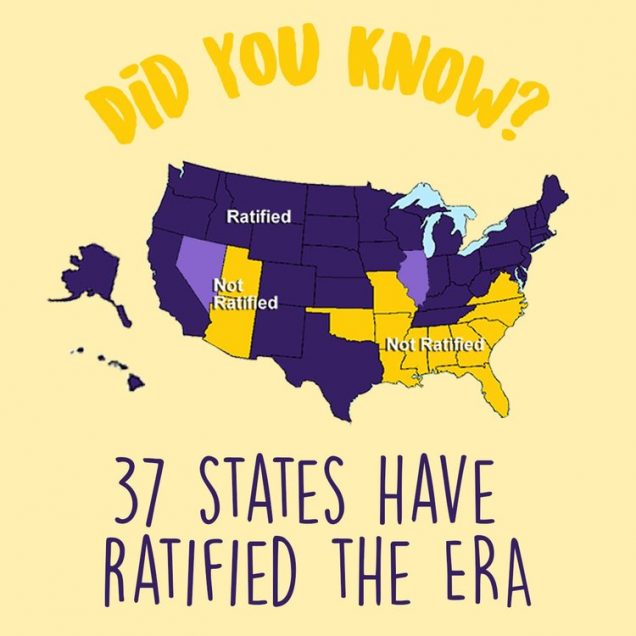
While the legal status of a 38th state ratification may be murky, the importance of the ERA today is clear. United States Supreme Court Justice Ruth Bader Ginsburg has supported the ERA, arguing that while recent women’s rights advancements through legislation are positive, it could be repealed without an underlying principle of equality enshrined in the Constitution. For example, a 2012 Wisconsin Act rolled back protections for victims of wage discrimination. Practically, the ERA’s heightened scrutiny on gender discrimination cases would go a long way in preventing rollbacks of laws protecting gender equality as well as preventing the implementation of laws that actively discriminate based on gender. For example, the ERA would likely have prevented the rollback of the Wisconsin wage equality law. Experts also argue that a heightened level of scrutiny for gender discrimination claims likely would have changed the outcome of the famous 2014 Burwell v. Hobby Lobby case, which allowed for-profit companies to deny its employees health coverage of contraception based on religious objections. If the ERA can win its final state ratification and pass through the many legal hurdles it faces, it would represent the realization of an almost century-long ordeal to ensure a basic principle of equal protection and rights under the law regardless of gender.
 Chloe Aubuchon graduated from the University of Michigan with a B.A. in International Studies and Spanish in 2017 and anticipates graduating from Boston University School of Law in May 2020.
Chloe Aubuchon graduated from the University of Michigan with a B.A. in International Studies and Spanish in 2017 and anticipates graduating from Boston University School of Law in May 2020.
Can Partisan Gerrymandering be Stopped?
Attention to partisan gerrymandering has heightened as the next wave of redistricting fast approaches and the Supreme Court’s 2017-2018 docket included two cases regarding the constitutionality of partisan gerrymander. Following the release of the 2020 census, states will set out to redraw their district maps. States redistrict at least every ten years. The 2010 redistricting results are described as the most extreme partisan gerrymandering in our country’s history. The 2010 maps have a heavy Republican partisan advantage, as evidenced by the 2012 election results with Republicans gaining a 234 to 201 seat advantage in the House of Representatives despite Democrats winning 1.5 million more votes than Republicans. The Republican partisan advantage has remained strong. The Brennan Center for Justice has predicted that in the 2018 midterm elections Democrats will need to win by a margin of nearly 11 points to gain a majority in the House of Representatives. Democrats, however, have not won by a margin this large since 1974. Following years of heavily gerrymandered districts, a supermajority of Americans have indicated support for the Supreme Court to bring an end to partisan gerrymandering, yet the Court failed to take action this year.
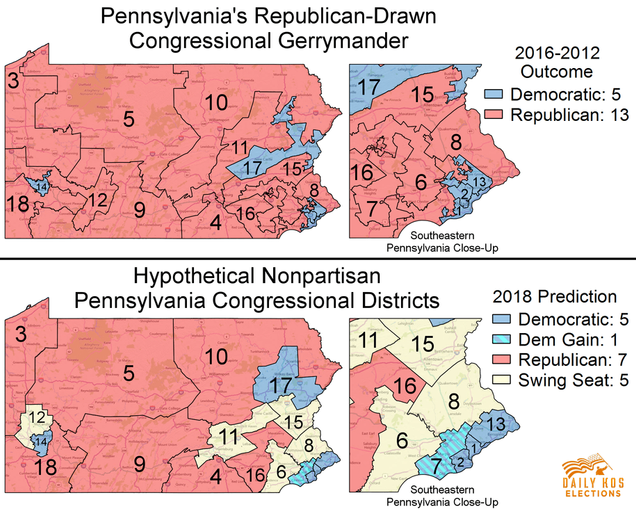 Partisan gerrymandering is the carving of districts, into sometimes odd shapes, to benefit a political party’s electoral prospects. The term gerrymandering was coined after Elbridge Gerry, a Massachusetts’s governor, in order to describe an irregularly shaped district that looked like a salamander in an 1812 redistricting map he signed into law. As a result, partisan gerrymandering has been a defining feature of “American politics since the early days of the Republic.” While racial gerrymandering is unconstitutional, the constitutionality of partisan gerrymandering is an open question, as the Supreme Court has never struck down a map for partisan gerrymander.
Partisan gerrymandering is the carving of districts, into sometimes odd shapes, to benefit a political party’s electoral prospects. The term gerrymandering was coined after Elbridge Gerry, a Massachusetts’s governor, in order to describe an irregularly shaped district that looked like a salamander in an 1812 redistricting map he signed into law. As a result, partisan gerrymandering has been a defining feature of “American politics since the early days of the Republic.” While racial gerrymandering is unconstitutional, the constitutionality of partisan gerrymandering is an open question, as the Supreme Court has never struck down a map for partisan gerrymander.
Partisan gerrymandering seems to fly in the face of democracy. Voting is a fundamental right and electing who you want to represent you in office is a fundamental part of democracy. Legislatures that scheme, plan, and manipulate maps to benefit one party over another can undermine the purpose of democracy. Some of this scheming, planning, and manipulating is self-interested as legislatures try to protect incumbents and create safe districts, but can also serve the purpose of entrenching a political party’s majority until the next redistricting cycle. Both parties, Republicans and Democrats, have enjoyed the benefit of partisan gerrymandering when given the opportunity.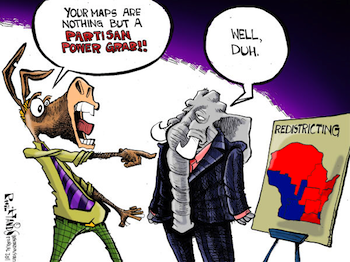
While the Supreme Court has indicated that some level of partisan gerrymandering may be unconstitutional, it has yet to explain when the constitutional line has been crossed. This term, the Supreme Court took up the question of partisan gerrymandering for the first time in more than a decade. The two cases before the Supreme Court were Gill v. Whitford and Benisek v. Lamone. The Supreme Court was asked to answer when partisan gerrymander crosses the constitutional line. Gill v. Whitford challenged a statewide map that has been deemed among one of the worst partisan gerrymandered maps in the country, with a significant Republican partisan advantage. Benisek v. Lamone challenged one congressional district in Maryland, with a significant Democratic partisan advantage. Some speculated that the Court took up both cases to deter an appearance that the Supreme Court prefers one party over the other. Another reason may be that the Wisconsin case was a challenge to a statewide map compared to the Maryland case challenging one congressional district.
The appellants attorney in Gill v. Whitford argued during oral arguments (see, page 62) that the Supreme Court is the only institution to put an end to partisan gerrymandering. The Court, however, sidestepped the entire issue by unanimously finding the Gill plaintiffs did not have standing, and that the challengers in Benisek had waited too long to seek an injunction blocking the district. The Supreme Court’s silence allows legislatures to continue to strategically gerrymander.
While the country waits on the Supreme Court to provide an answer on the constitutionality of partisan gerrymander, some states have attempted to take partisanship out of the process by using redistricting commissions, while others suggest that computers with algorithms should produce the maps. Yet, neither of these options individually seem to completely insulate redistricting from politics.
States have adopted redistricting commissions with the intention to remove partisanship from the redistricting process. However, this has often proved difficult to achieve, as finding non-partisan committee members is difficult and oftentimes the commission is appointed by partisan members, such as elected representatives and governors. States use different types of commissions and may only use a commission for redistricting the state map or congressional map. About 23 states use commissions for the state legislative maps and about 14 states use commissions for the congressional maps. The redistricting commissions can take the form of an advisory commission that makes suggestions to the legislature, a backup commission that draws the map if the legislature fails to redistrict, or as having the primary responsibility of drawing the map.
Even states that use independent redistricting commissions have had difficulties completely insulating the process from politics. For instance, in 2011, Arizona’s Independent Redistricting Commission chairwoman was removed by the Republican Governor and the Republican-controlled State Senate. The Governor accused the chairwoman of skewing the process for Democrats. The Arizona Supreme Court, however, reinstated the chairwoman and the United States Supreme Court upheld Arizona’s independent redistricting commission as a legitimate way to draw district maps. Although some states are moving toward redistricting commissions as a way to insulate the process from politics, these commissions are “only as independent as those who appoint it.”
While technological advances have been thought to help parties gerrymander more effectively, some suggest that similar technology could take politics out of the process with the proper algorithms. Brian Olson, a Massachusetts software engineer, wrote an algorithm to create “‘optimally compact’ equal-population congressional districts.” Olson prioritized the compactness requirement in an effort to reflect “actual neighborhoods” and because dramatically non-compact districts can be a “telltale sign of gerrymandering.” However, political scientists are skeptical about an algorithm prioritizing compactness, because it ignores other important factors, such as community of interest. Furthermore, someone needs to set the algorithm and there can be infinite map results. Thus, without very strict restrictions and guidelines, setting an algorithm and picking the map can still be an inherent gerrymander.
Removing politics completely from the redistricting process appears to be nearly impossible. Partisanship is deeply entrenched in the process, and dates back to even before the coined term “gerrymander.” Redistricting commissions do not always guarantee a partisan free redistricting effort, and while technology offers an alternative to human map drawing, humans are still making the final decision. Some combination of these efforts may help to lessen the amount of politics used in the redistricting process or lessen the appearance of partisanship, but are unlikely to completely end partisan gerrymandering all together.
 Mikayla Foster anticipates graduating from Boston University School of Law in May, 2019.
Mikayla Foster anticipates graduating from Boston University School of Law in May, 2019.
Raising the Minimum Wage: Look No Further Than Your Own Backyard
By: Brynn E. Felix
The United States has a minimum wage problem. In 2015, roughly 2.6 million workers earned at or below the federal minimum wage—a measly $7.25 per hour. The federal minimum has not budged since 2009 and continues to depreciate in value: by 2015 the $7.25 hourly wage had already lost approximately 8.1% of its purchasing power to inflation. With a looming Trump administration likely falling in lock-step with a Republican-controlled House and Senate, it seems safe to predict that the federal minimum isn’t going anywhere for the next four years.
Efforts by Democrats to raise the federal minimum wage to $10.10 largely stalled out, even after a letter signed by 600 economists supported the hike. Citing “close to 17 million workers” who would benefit from the raise, the economists pointed to
“important developments in the academic literature on the effect of increases in the minimum wage on employment, with the weight of evidence now showing that increases in the minimum wage have had little or no negative effect on the employment of minimum-wage workers, even during times of weakness in the labor market. Research suggests that a minimum-wage increase could have a small stimulative effect on the economy as low-wage workers spend their additional earnings, raising demand and job growth, and providing some help on the jobs front.”
Pros & Cons of Increasing the Minimum Wage
In addition to the economic arguments provided by the 600 economists who favor raising the minimum wage, proponents also point to the fact that the current minimum wage fails to provide a living wage for workers living in urban centers and places with higher costs of living. Indeed, the value of the minimum wage has significantly declined since the 1960s and 1970s. Moreover, low wage earners are more likely to spend the majority of their income locally, which benefits the local economy. In addition to the economic arguments, proponents have effectively framed the narrative as pursuit of economic justice. Too many working families are struggling to make ends meet, juggling multiple jobs with no relief in sight.
 Critics claim that forcing businesses to raise the minimum wage will inevitably cause them to reduce their employment ranks, rendering “many less skilled workers unemployable.” A wage hike would mean fewer jobs and an increase in unemployment. In response to Senator Bernie Sanders’ proposal to raise the federal minimum wage to $15, the Heritage Foundation claimed that approximately seven million full time jobs would be eliminated by 2021. Moreover, doubling the federal minimum wage would have a greater impact on states with lower costs of living. In a nutshell, opponents decry minimum wage increases as “’feel good, sound good’ policies that appease the masses, harm businesses, and displace workers.”
Critics claim that forcing businesses to raise the minimum wage will inevitably cause them to reduce their employment ranks, rendering “many less skilled workers unemployable.” A wage hike would mean fewer jobs and an increase in unemployment. In response to Senator Bernie Sanders’ proposal to raise the federal minimum wage to $15, the Heritage Foundation claimed that approximately seven million full time jobs would be eliminated by 2021. Moreover, doubling the federal minimum wage would have a greater impact on states with lower costs of living. In a nutshell, opponents decry minimum wage increases as “’feel good, sound good’ policies that appease the masses, harm businesses, and displace workers.”
Fight for 15
The Republican-controlled 114th Congress needed no further convincing.
Seeing their prospects fade at the federal level, minimum wage advocates have reacted by strategically shifting their efforts to local reforms. Municipalities in particular have become the forefront of the movement for a living wage.
Seattle was the first major metropolitan city to enact a minimum wage hike amid the failed effort to increase the federal minimum wage. In early 2014, Seattle saw months of contentious debates and public demonstrations, bringing thousands of strikers and economic justice activists to the streets. The “Fight for 15” campaign had officially begun.
“It was the experience of a lifetime,” said former McDonald’s worker Martina Phelps. “After seeing my co-workers literally struggling and not having enough money to take care of their children, it was set in my mind that I can do something about this.”
Labor triumphed. By June of 2014, the Seattle City Council unanimously approved a city ordinance that raised the $9.50 an hour wage to $15 an hour. “No city or state has gone this far,” one councilmember noted, “We go into uncharted territory.” The ordinance contains different phase-in schedules that vary by business size: employers with 500 or more employees will pay $15/hour by 2017, while smaller businesses have until 2021 to gradually implement the raise. The first increases took place in April of 2015, while large employers currently pay $13/hour.
Building on Seattle’s success, the Fight for 15 spread like wildfire to other urban centers and state legislatures.
By December 2015 Chicago mayor Rahm Emanuel signed into law an ordinance to raise the city’s minimum wage to $13/hour by 2019. Three months later California legislators enacted a law that will elevate the state minimum wage to $15/hr by 2022. New York legislators followed suit with their own $15/hr measure, which will take effect in New York City by 2018.
In the meantime, the University of Washington’s Evans School of Public Policy and Governance published a study in July 2016, noting that Seattle’s wage increase had elevated the pay of minimum wage workers by nearly 12%, in contrast to a 5% increase seen by workers just outside the city limits. While the preliminary study concluded that low-wage workers’ employment levels and wages rose, the media continued to promote polemic interpretations of the study’s results. Supporters and opponents alike, eager to vindicate their own predictions, used the report to claim victory over their opponents. These two headlines are from the Seattle Times (July 25, 2016) and Forbes (July 26, 2016), respectively:
What actually happened? In reality, by July 2015, data demonstrated that the wage hike had a minor impact on employment and numbers of hours worked, along with significant increases in wages earned. Signs of misleading reporting were documented by the New Yorker: “Last February [2016], the Washington Policy Center and the American Enterprise Institute suggested that several Seattle restaurants were closing in anticipation of having to pay their staff more, though when a Seattle Times report went out to interview the owners she found more mundane causes: a bad location, a rebranding.“
Despite several media outlets prophesizing negative economic consequences of raising the minimum wage, voters in Arizona, Colorado, Maine, and Washington overwhelmingly approved November ballot measures to increase their respective state minimums. In total, 29 states now offer a higher minimum wage than the federal minimum.
Where do we go from here? Oregon may give us a clue.
With a few exceptions, the “Fight for 15” victories largely occurred on Democratic turf. In its article, The Bitter Lesson From Seattle’s Minimum Wage Hike, Investor’s Business Daily lamented:
“[S]uch foolishness seems to have infected the Democratic Party, with its now near-ubiquitous ‘Fight for $15’ campaign…forcing sharply higher wages on troubled local economies where the median wage is low and can have a devastating effect.”
Fears that increasing the minimum wage could harm states with lower costs of living are not unfounded; however, that alone should not be the reason for jurisdictions to reject minimum wage increases. Indeed, Oregon offers an innovative model that addresses concerns about significant economic disparities head on. In March of 2016 the Oregon State Legislature enacted a statewide law that raises the minimum wage, set at $9.25 at the time of passage, to $12.50, $13.50, or $14.75 by 2023—depending on the region. To accommodate both the high cost of living in Portland and the economic differential in nonurban counties, the legislature devised a system that divides the state into three regions: Standard, Portland Metro, and Nonurban Counties. By 2023, the Standard minimum wage will reach $13.50 and will be adjusted annually to compensate for any increases to the Consumer Price Index for All Urban Consumers. The Portland Metro area will hover at $1.25 above the Standard wage, while the minimum wage in Nonurban Counties will be fixed at $1 below the Standard minimum:
This multi-layered approach addresses many of the issues that may arise when different regional economies are subjected to uniform across-the-board wage hikes. By centrally managing wages by locality, Oregon was able to legislate for each sub-region’s unique economic situation. While such a plan might prove to be unconstitutional at the federal level due to the requirement that states be treated equally under the law, this approach may nevertheless provide a blueprint for other states that struggle with satisfying the needs of wildly different demographics.
The Takeaway
One of the greatest silver linings to emerge from the gridlock, obstructionism, and ever-intensifying polarization of Congress is the reminder that inaction at the federal level does not have to stall progress at the local level. Municipalities and local governments have proven to be successful incubators of policies that help the working poor. In Washington, a bold proposal in 2014 to raise the city’s minimum wage to $15 an hour catalyzed momentum for a statewide vote in 2016 to raise the state’s minimum wage to $13 an hour. Similarly, state legislatures like Oregon are adopting wage increases with creative and innovative implementation schemes. Only time will tell what effects these experiments will have—and how the media will attempts to shape the underlying narrative—but in the meantime, local advocates and policymakers should take full advantage of these beautiful laboratories.



